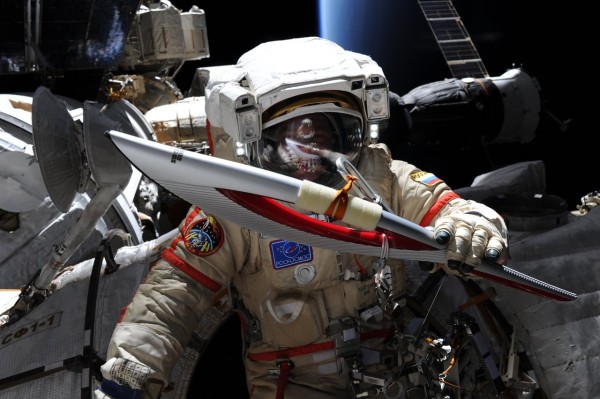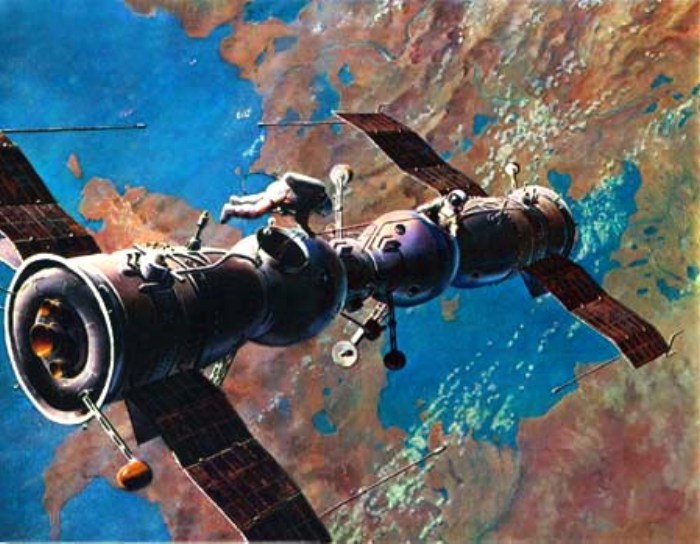Unusual items that have been in space

Man is not always a rational being. Therefore, in space there were things that were not planned by the flight program, carried by smuggling, or, despite their legal status, are still worthy of mention.
Once upon a dime
It all started, probably, even before the man’s flight into space. Even when dogs were launched in the USSR, there were fierce debates among mostly non-technical personnel - will a mechanical watch work in zero gravity? And so, after the landing of the Chernushka dog, a nominal watch is found sewn to the dog blanket and smuggled around the globe on March 9, 1961. The owner of the watch, aviation physician Abram Moiseevich Genin, of course, received a rather serious “fly” for unauthorized experiments, however, he was immediately praised by Korolev for decisiveness [1] .
The Americans started this too very early. Already in the second flight under the Mercury program, astronaut Gas Grissom took two packs of fifty-ten-cent coins, several small models of the Mercury capsule, three one-dollar banknotes, and two sets of pilot wings for souvenirs [2] . However, almost immediately after landing, he regretted it - the hatch of the capsule spontaneously shot off, the capsule began to sink, the spacesuit also scooped up water, pulled down, and the excess weight was obviously useless. You can watch a dramatic video . Grisom’s “Decadecents” are now rumored to be trading on the Internet, but I suspect they are fakes.
The next notable incident occurred during the flight of the Gemini 3. Astronaut John Young took with him on a regular sandwich from an ordinary diner near the launch site [3]. And with a stone face he offered his partner Grissom. Judging by the recording of the negotiations in the cockpit, the astronauts failed to enjoy the sandwich, most likely it began to crumble. Crumbs are dangerous in zero gravity - they can get into the eye, trachea or technique and cause problems up to a short circuit. After the landing, a scandal broke out at the Congress level - a politician demanded a reduction in the financing of the space program, calling such tricks a mockery. Curiously, the story is rather dark, because it is not clear that Young smuggled him, or with the permission of Dick Slayton, the head of the astronaut bureau, or this unfortunate sandwich slipped him astronaut Walter Shirra, who loved jokes. In any case, despite the scandalous nature of the story, neither Young nor Grissom received significant punishment,
The achievement “First Space Mail” was taken by the USSR when the cosmonauts Khrunov and Eliseev in spacesuits “visited” astronaut Shatalov, passing between the docked Soyuz-5 and Soyuz-4 and transmitting letters, telegrams and newspapers to the latter after its launch [4] .

There are many places in the lunar module
Various unusual objects began to fly into space almost on a regular basis during the American lunar program.
Apollo 11 was carrying part of the Wright brothers' propeller and wing [5] and diamond-encrusted badge of astronaut Dick Slayton, who, due to health problems, did not receive access to space flights.
On the Apollo 12, the self-timer flew to the Hasselblad camera [6] . Astronaut Alan Bin wanted to take a shot with two astronauts together - a unique photo and a drawing of scientists. Alas, a small self-timer was lost in things, he was not found on time, and Bean had only to paint the picture “Awesome photo that we did not do”. By the way, he has many nice, albeit somewhat monotonous, pictures here .

Apollo 14 delivered a golf club to the moon (the thread coincided with a sample collection tool) and a pair of balls. The spacesuit is an uncomfortable golf clothing, and despite the statement “miles, miles and miles”, Alan Shepard’s balls flew away just a few hundred meters [7] . Edgar Mitchell did not remain in debt and threw the regular handle of some equipment like a spear. You give the Olympics on the Moon :) In fairness it should be noted that golf was still “played” in Earth orbit in 2006, but it was an advertisement for golf products, and I don’t want to promote it.
Apolon-15 was probably the largest collection of all sorts of stuff for its era. Firstly, astronauts took a falcon feather with them and conducted a short physics lesson live:
Secondly, the astronauts held a very touching ceremony for all the dead astronauts and astronauts who knew them, leaving a tablet with their names and a figure of the Fallen Astronaut on the moon [8] .
And thirdly, in addition to the legal envelopes they had to stamp, the astronauts took four hundred more illegal ones, which they planned to make money on [9] . It turned out an ugly story, not only the direct participants were punished from the astronauts, and NASA began to very seriously control the things that astronauts taking into space took with them. Personal Preference Kit (NAS) began to be handed over to NASA in advance, so that the agency viewed and allowed or did not allow things to fly.
And on the shuttles - even more
Space Shuttle is a big car. Numerous crews, a lot of free space, and even they flew almost constantly with underload. Therefore, the bill for all sorts of curious gizmos here already begins to go to hundreds. And only very unusual ones come to mind:
At the STS-51F mission, an experiment was conducted on the consumption of carbonated drinks in zero gravity. If it weren’t for the educational benefits, I would not talk about this case. Because the drinks were Coca-Cola and Pepsi, and this experiment was very weighed down by marketing. Both companies assembled devices to open a regular can of soda (structurally different), and astronauts tested the convenience of consumption and the taste of the contents. The results were so-so - instead of liquid in zero gravity, foam was produced from soda, and there were no refrigerators on the Shuttle[10] .

Since we are talking about liquids in zero gravity, it is worth recalling the stories with Soviet cosmonauts. According to an interview with George Grechko [11] , he participated in the smuggling of canned beer into orbit. Without a special device for drinking, embarrassment turned out - the foam scattered across the walls, there was nothing to drink. There is also a very famous story about a flask with cognac. In the version that I liked most, the first crew, having forgotten the physics, was able to drink only half of the flask, because in weightlessness cognac and air were mixed, and it was not possible to drink. The next crew did not leave school physics and quick wits on Earth and drank cognac, creating artificial overload.
Well, before returning to the Shuttles, it is worth recalling a couple of Soviet stories.
Soyuz-17 docked with Salyut-4 station. Cosmonauts Gubarev and Grechko open the hatch and see the poster “When you enter the house, wipe your feet” [1] - greetings from those who assembled and launched the station.
The second Soviet woman-cosmonaut, Svetlana Savitskaya, has been met to this day by a sexist joke - an apron in a flower [12] . Savitskaya herself brought a blouse with lead weighting materials for the effect of wings. According to rumors, it turned out beautifully.
STS-117 brought into space an archaeological exhibit - a tablet from the Jamestown colony in 1607 [13] .
Well, already beyond the bounds of absurdity is a capsule with earth from the favorite stadium of one of the astronauts STS-123 [13] .
Unions and ISS
The Soyuz has long had a tradition - as a “gravity indicator”, each crew takes with them a small toy mascot. Now the black cat Dimler of the Soyuz TMA-10M crew commander Oleg Kotov and the white Olympic bear of the Soyuz TMA-11M crew are on the watch at the ISS. By the way, the increase in toys in orbit happened - flight engineer Karen Nyberg in her free time sewed a toy from an old T-shirt and fabric, which was covered with Russian food containers [14] .

Well and, of course, the recent torch story. The article has been waiting for photos in high resolution for two weeks now.
In fairness, it should be noted that this is the third torch that was in orbit - the first time the Olympic torch flew into space in 1996 on STS-78, the second - in 2000 on STS-101 [15]. But here the launch of the torch into space with the “relay race” at the VVD is the first time:

This is not quite an “object”, but the rocket itself was unusual - a film in the style of “patchwork” was pasted on top of fuel tanks and other non-cryogenic sites. I don’t remember any other launch vehicles being artistically designed:

Well, the last photo very well reflects the fact that flying into space is a joint work of a large number of people:

